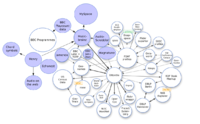
Photo from wikipedia
At present, there is still no officially accepted and extensively verified implementation of computing the gamma difference distribution allowing unequal shape parameters. We explore four computational ways of the gamma… Click to show full abstract
At present, there is still no officially accepted and extensively verified implementation of computing the gamma difference distribution allowing unequal shape parameters. We explore four computational ways of the gamma difference distribution with different shape parameters resulting from time series kriging, a forecasting approach based on the best linear unbiased prediction and linear mixed models. The results of our numerical study, with emphasis on using open data science tools, demonstrate that our computational algorithm implemented in high-performance Python(with Numba) is exponentially fast, highly accurate and very reliable. It combines numerical inversion of the characteristic function and the trapezoidal rule with the double exponential oscillatory transformation (DE quadrature). At the double 53-bit precision, our open tool outperformed the speed of the analytical computation based on Tricomi's function in CAS software (commercial Mathematica, open SageMath) by 1.5–2 orders. At the default precision of scientific numerical computational tools, it exceeded open SciPy, NumPy and commercial MATLAB 5–10 times. The potential future application of our tool for a mixture of characteristic functions could open new possibilities for fast data analysis based on exact probability distributions in areas like multidimensional statistics, measurement uncertainty analysis in metrology, as well as in financial mathematics, and risk analysis.
Journal Title: Journal of Statistical Computation and Simulation
Year Published: 2022
Link to full text (if available)
Share on Social Media: Sign Up to like & get
recommendations!